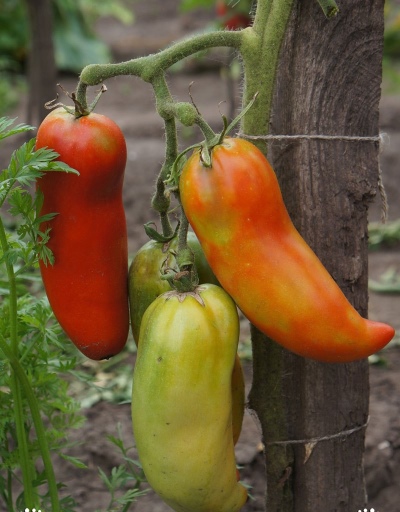
- Authors: Shott Z. I., Gilev M. A. (Agrofirm "Demetra-Siberia" LLC)
- Year of approval: 2007
- Category: grade
- Growth type: indeterminate
- Appointment: fresh consumption, for whole-fruit preservation, for juice, for ketchup and tomato paste
- Ripening period: mid-season
- Ripening time, days: 111-115
- Growing conditions: for open ground, for film greenhouses
- Transportability: good
- Bush size: tall
When you want to grow a large tomato with universal fruits on your plot, you should try the Pepper Giant. Tomato of this variety requires little maintenance and adherence to agricultural technology, which can result in a large harvest.
Description of the variety
The plant belongs to varietal, it has unlimited growth. Grows well in greenhouses and outdoors. The bushes grow tall as it is an indeterminate variety. The maximum height is 2 meters. The foliage is formed in a large, dark green color.
The fruits are suitable for table setting and canning, they are used to prepare delicious juices and tomato paste.
The main qualities of the fruit
Unripe Pepper Giant tomatoes have a dark spot at the stalk. When ripe, they are red.
Tomatoes of this type are large in size, weighing up to 200 grams. Their shape is obovate. Up to 9 fruits can form in one brush. Under the thick, smooth skin, there is a fleshy, dense flesh. The Pepper Giant has few seeds.
Taste characteristics
The tomatoes of this variety taste sweet.
Ripening and fruiting
The pepper-shaped giant is a mid-season variety, ripens from 111 to 115 days. Bears fruit for a long time, from July to September there is a picking of tomatoes.
Yield
The plant belongs to high-yielding varieties, with an indicator of 6 kg / sq. m.
The timing of planting seedlings and planting in the ground
From the beginning to mid-March, they begin to plant the variety on seedlings, it is transferred to the ground from mid-May to early June.

Growing tomato seedlings is an extremely important process, because it largely depends on whether the gardener will be able to harvest at all. All aspects must be taken into account, from seedbed preparation to planting in the ground.
Landing scheme
The ideal planting pattern is 60 x 50 cm.

Growing and care
Sow the seeds of the Pepper Giant Tomato in a thin layer on top of good quality compost and sprinkle with water. They usually germinate for about 7 to 14 days at a temperature of about 21 ° C. Keep the compost moist, but remember that excessive moisture leads to various diseases and diseases.
The garter and shaping are necessary for the plant. Leave 3 stems for a rich harvest.
If the tomatoes of the Pepper Giant begin to shed their leaves and fruits, this indicates that they do not have enough moisture, they need to be watered more often and more abundantly. In order for tomatoes in a greenhouse to give a generous harvest, the combination of the three main conditions for proper growth - lighting, moisture and feeding - must be optimal and timely.
Also, the tomato may begin to crack. This is a fairly common problem for greenhouse plants. Especially dense tomatoes, which include the Pepper Giant, crack.This is a kind of reaction that can be associated with overheating of the soil, or abundant watering after the tomatoes have survived a drought, as well as with a lack of micronutrients.
In this case, the grower is required to carry out a number of activities.
Maintain the level of humidity in the air. In the greenhouse, it should be 50% or more.
Water regularly and evenly.
Apply soil mulching.
Ventilate the greenhouse.
Shade the area from the scorching sun with agrofiber.
Growing Tomatoes The Pepper Giant indoors gives an early harvest. It is recommended to plant young bushes with a height of about 15-20 cm, when the flowers are just beginning to open. It is not recommended to plant tomatoes twice on the same soil. The optimum temperature for the successful cultivation of tomatoes is + 21 ... 24 ° С, but they can grow poorly if the indicator is above + 27 ° С or below + 16 ° С.
The soil should have a pH level of 5.5-6.8, be fertile, well-drained and rich in organic matter.




A plant needs different micronutrients at each stage of growth. All fertilizers can be divided into two groups: mineral and organic. Folk remedies are often used: iodine, yeast, bird droppings, eggshells.
It is important to observe the rate and period of feeding. This also applies to folk remedies and organic fertilizers.
Disease and pest resistance
The Pepper Giant does not have good immunity to diseases, therefore, it is sprayed with fungicides from the seedling stage. Processing is carried out every 10 days until the fruit ripens.
Commercial insecticides have worked well for insects.
For powdery mildew, tomatoes are sprayed with a solution of copper sulfate. The damaged leaves are broken and burned. Complex fertilizers with a high content of phosphorus and potassium are additionally introduced into the soil. Spraying with infusion of cow dung helps a lot.
It is more difficult to get rid of phytophthora. We'll have to turn to special drugs such as Fitosporin. The affected leaves are cut off, the tomatoes are sprayed with iodine solution (10 ml per bucket of water), this procedure is repeated twice, with an interval of 3 days.
To avoid apical rot, the Pepper Giant must be fed with calcium. To do this, make an infusion of eggshells, pouring them under the root while still in the seedling stage.


Growing regions
The variety is grown in all regions of Russia.

























































































